Local sights to visit around Insch

Dunnideer Castle
Dunnideer Castle or Fort is a ruined tower house near Insch visible from many parts of the town including The Station Hotel.
Recycling stone from a prehistoric hillfort dating to about 250BC, the castle was built around 1260 with walls some 15 metres (49 feet) high and 1.9 metres (6.2 ft) thick. It no doubt contained multiple storeys.
The castle, now a mere stone shell, is one of Historic Environment Scotland's scheduled monuments.
As can be noted from "The Castle of Dunnydure" exhibition at the local Insch Connection Museum, Dunnydeer (or Dunnideer) Castle is probably the earliest tower house on the Scottish mainland with links to Sir John de Balliol, King of Scots from 1292 to 1296.
The site is open to the public and offers superb panoramic views of Aberdeenshire after a short climb.
Photo by Eloise Halkett with kind permission of Rambo, the French Bulldog.

Photo courtesy of Wikimedia Commons
St Drostan’s Church
St Drostan's is a beautiful red brick church centrally located on Commerce Street, Insch, within easy walking distance of The Station Hotel and holds a service every Sunday at 10am.
Everyone is welcome at St Drostan's Episcopal Church, part of the Anglican community. The congregation is part of the Diocese of Aberdeen and Orkney.
Drostan was an Irish-Scottish abbot who was entrusted at an early age to the care of St. Columba and was one of the twelve companions who accompanied him from Ireland to Scotland around 563.
Drostan became abbot of the church of Deir, but eventually opted for a life of seclusion and moved to Glenesk where he became a hermit with numerous miracles being attributed to him.
St Drostan is celebrated on December 15th each year.

Photo courtesy of Wikimedia Commons
The Picardy Stone
The Picardy Stone is a Pictish monolith, 2 metres high, which once stood on a stone cairn under which was a grave.
It is a Class I Pictish stone and is rare in that it can be found still in its original position.
Made of whinstone with quartz veins, it has been incised with a double-disc and Z-rod, above a serpent and Z-rod along with a mirror symbol.
You'll be able to see Dunnideer from this viewpoint.
If you intend to visit The Picardy Stone which sits two miles north-west of Insch, remember that it stands in a field where there is often livestock. There is only limited roadside parking available.
A Pictish stone is a carved or incised monumental stone, or stele, from the time of the Picts in Scotland, dating from roughly the 5th to 9th centuries.
While the exact meaning of their symbols is still debated, many researchers believe they may represent names or have a commemorative purpose.
A leading theory is that the symbols might have represented Pictish names. No matter what, the stones are crucial for understanding Pictish culture, especially as the people became Christianised.
They are most common in the north and east of Scotland and the purpose and exact meaning of the symbols remain a mystery, with no surviving contemporary documents to explain them.

Photo courtesy of Bobbie Jeal
Insch Connection Museum
The Insch Connection Museum is located straight across the road from The Station Hotel in what used to be the ticket office and the ladies' waiting room of Insch railway station.
The Museum houses numerous displays, artefacts and photographs that give a glimpse into the life of Insch over the years, including a scale model of Dunnideer Castle and old maps.
There is also a scale model of the station at a time when the layout of tracks was more complex than today, with the railway station being of strategic importance to the local community and its surrounding areas.
Model trains operate and there are also wooden ones for children to play with.
The Museum is open from April to October every year from 2pm to 4pm on Wednesdays and Sundays. However, outwith these opening times, the volunteers are happy to welcome groups or school parties at a suitable time. For wheelchair access, please enter from the station car park and use the ramp to the platform.
Premnay was a parish in the district of Garioch (pronounced Geery) in Aberdeenshire. It encompassed parts of Insch including the railway station and The Station Hotel. The railway line at the time was known as the Great North of Scotland Railway.
As described in Frances Groome's Ordnance Gazetteer of Scotland, 1882-84 (1), Premnay also included the villages of Rothney and Auchleven.
The village of Auchleven tends to still be known locally as Premnay. The postcards here were kindly gifted by Ian Crick of St Leonards-on-Sea whose step-grandfather was one Willie Reid whose mother, in turn, was a Mrs Brown who lived in Premnay. Unusually, The Station Hotel had a different name in these postcards and appears to have been known at one time as The Premnay Hotel.
If you hover over this image, you will see a similar one with what is presumably the same horse and cart, but this time, the driver has climbed up into the cart and sits in front of the hotel. There are also a few children on the side staircase which no longer exists. Nor does the annexe on the left-hand side of the hotel on these cards.
(1) Taken from GB Historical GIS / University of Portsmouth, History of Premnay in Aberdeenshire | Map and description, A Vision of Britain through Time. URL: https://www.visionofbritain.org.uk/place/16383. Date accessed: 4th November 2025.


